fog light Alfa Romeo 8C 2007 Owner handbook (in English)
[x] Cancel search | Manufacturer: ALFA ROMEO, Model Year: 2007, Model line: 8C, Model: Alfa Romeo 8C 2007Pages: 223, PDF Size: 14.35 MB
Page 63 of 223
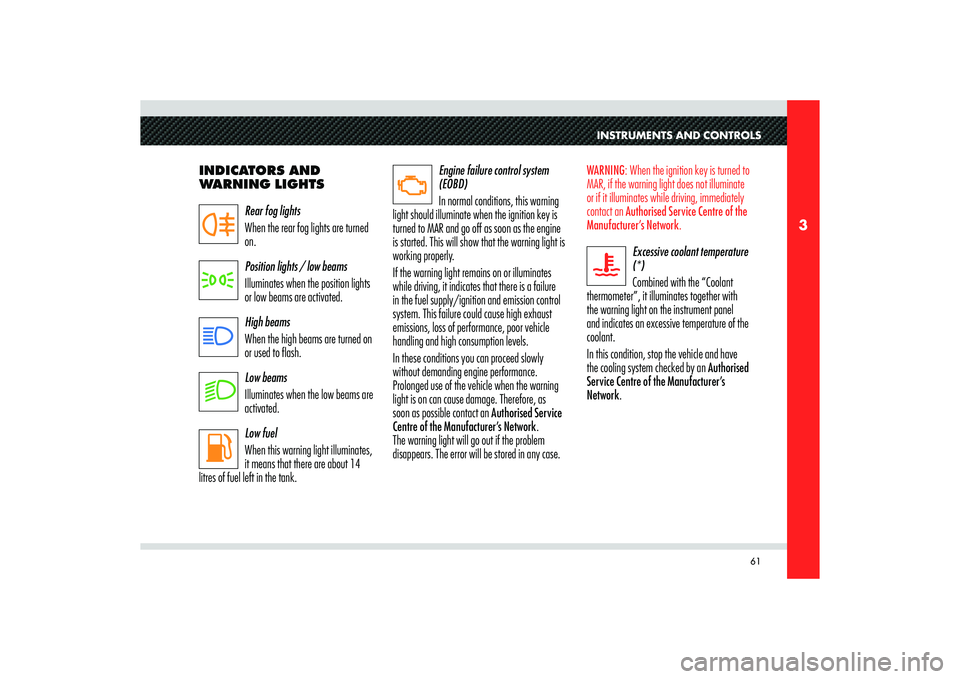
61
3
INSTRUMENTS AND CONTROLSWARNING: When the ignition key is turned to
MAR, if the warning light does not illuminate
or if it illuminates while driving, immediately
contact an Authorised Service Centre of the
Manufacturer’s Network.
Excessive coolant temperature
(*)
Combined with the “Coolant
thermometer”, it illuminates together with
the warning light on the instrument panel
and indicates an excessive temperature of the
coolant.
In this condition, stop the vehicle and have
the cooling system checked by an Authorised
Service Centre of the Manufacturer’s
Network. INDICATORS AND
WARNING LIGHTS
Rear fog lights
When the rear fog lights are turned
on.
Position lights / low beams
Illuminates when the position lights
or low beams are activated.
High beams
When the high beams are turned on
or used to flash.
Low beams
Illuminates when the low beams are
activated.
Low fuel
When this warning light illuminates,
it means that there are about 14
litres of fuel left in the tank.Engine failure control system
(EOBD)
In normal conditions, this warning
light should illuminate when the ignition key is
turned to MAR and go off as soon as the engine
is started. This will show that the warning light is
working properly.
If the warning light remains on or illuminates
while driving, it indicates that there is a failure
in the fuel supply/ignition and emission control
system. This failure could cause high exhaust
emissions, loss of performance, poor vehicle
handling and high consumption levels.
In these conditions you can proceed slowly
without demanding engine performance.
Prolonged use of the vehicle when the warning
light is on can cause damage. Therefore, as
soon as possible contact an Authorised Service
Centre of the Manufacturer’s Network.
The warning light will go out if the problem
disappears. The error will be stored in any case.
Page 65 of 223

63
3
INSTRUMENTS AND CONTROLS
Right-hand direction indicators
It illuminates when the right-hand
direction indicators or the hazard
lights are turned on.
Left-hand direction indicators
It illuminates when the left-hand
direction indicators or the hazard
lights are turned on.
Cruise Control
It indicates that the constant speed
regulator, Cruise Control, is active.
(*) Viewed on the display as wellWARNING LIGHTS ON
THE DISPLAY
Inertia switch, fuel cut-off
enabled
It illuminates when a collision
activates the inertia switch, thus cutting off the
fuel supply.
CAUTION
After an impact, if you smell
fuel or note leakages from the fuel
system do not re-activate the switch in
order to prevent the risk of fire.
Windscreen washer fluid
It indicates a low level of washer
fluid in the windscreen washer tank.
Alternator failure
If there is a fault in the recharging
system. When the battery is
insufficiently charged or overcharged. Lighting system failure
It illuminates in the case of a system
failure or if the position, direction
indicator, rear fog and number plate lights are
blown.
Stop light failure
It illuminates in the case of a system
failure or if the stop light is blown.
Twilight sensor failure
It illuminates on in the case of a
failure of the twilight sensor.
Engine oil temperature
It illuminates when the temperature
reaches high values. In this case,
reduce the engine RPM until the warning light
goes out.
Page 71 of 223
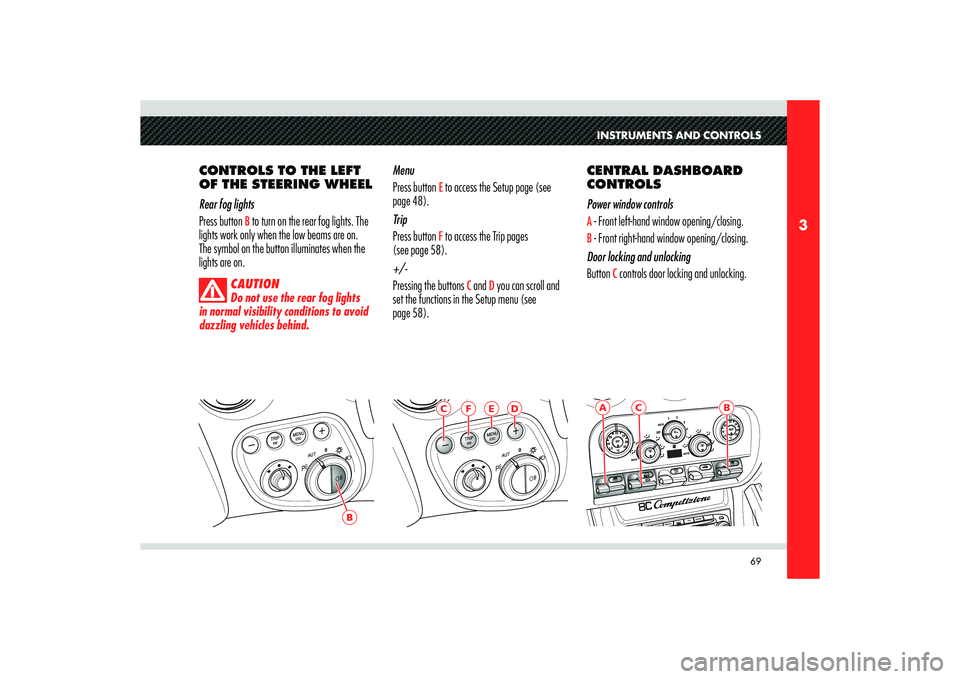
69
3
B
C
B
AINSTRUMENTS AND CONTROLS
CONTROLS TO THE LEFT
OF THE STEERING WHEEL
Rear fog lights
Press button
B to turn on the rear fog lights. The
lights work only when the low beams are on.
The symbol on the button illuminates when the
lights are on.
CAUTION
Do not use the rear fog lights
in normal visibility conditions to avoid
dazzling vehicles behind.
Menu
Press button
E to access the Setup page (see
page 48).
Trip
Press button F to access the Trip pages
(see page 58).
+/-
Pressing the buttons
C and
D you can scroll and
set the functions in the Setup menu (see
page 58).CENTRAL DASHBOARD
CONTROLS
Power window controls
A - Front left-hand window opening/closing.B - Front right-hand window opening/closing.
Door locking and unlocking
Button
C controls door locking and unlocking.
E
F
C
D
Page 98 of 223

96
4
AUTOMATIC
ACTIVATION/
DEACTIVATION
When the switch
A is turned to AUTO and the
ignition key is turned to MAR, the position lights,
low beams and number plate lights automatically
turn on and off according to the ambient light.
WARNING: The high beams can only be turned
on manually by pushing the left-hand lever
forward.
CAUTION
If the high beams are activated,
they will be switched on automatically
every time the lights are turned on.
We recommend therefore that you
turn them off every time the twilight
sensor deactivates the external lights.CAUTION
In case of fog during the day,
the position lights and low beams will
not be activated automatically. The
driver must always be prepared to
turn on the external lights manually,
even the rear fog lights if necessary.
WARNING: After automatic activation of the
external lights, it will always be possible to
turn on the rear fog lights manually. When the
external lights turn off automatically, also the
rear fog lights (if on) will be turned off. The next
time the external lights activate automatically,
the rear fog lights will have to be turned on
manually if necessary. CAUTION
The driver is always
responsible for turning on the external
lights, depending on the ambient light
and in compliance with the regulations
in force in the country of use. The
automatic system for activating/
deactivating the external lights must
be considered an aid for the driver. If
necessary, turn the lights on and off
manually.
Page 132 of 223
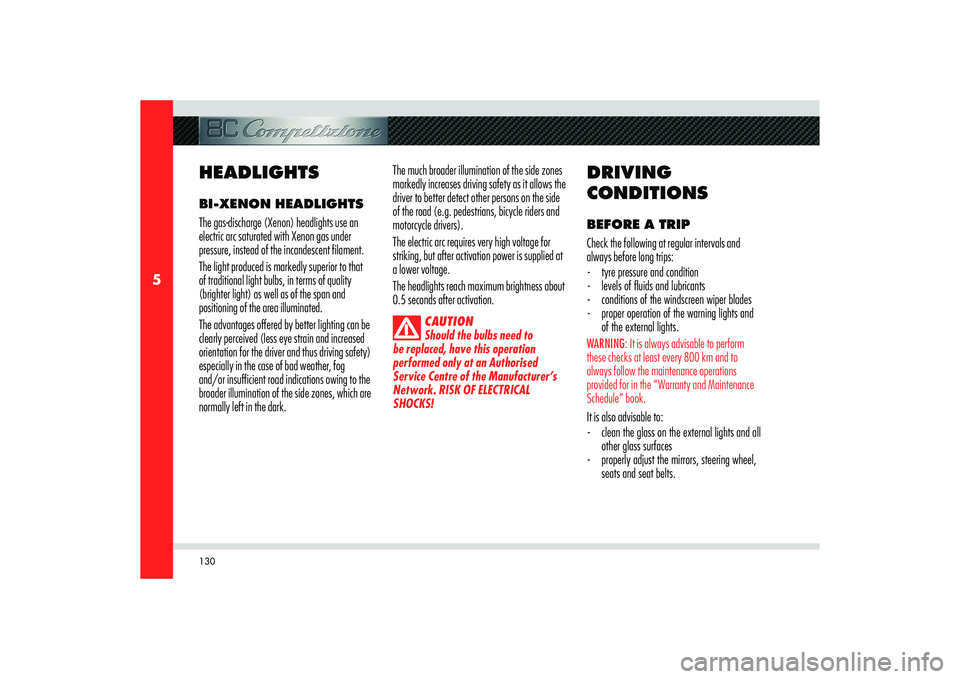
130
5
HEADLIGHTSBI-XENON HEADLIGHTS
The gas-discharge (Xenon) headlights use an
electric arc saturated with Xenon gas under
pressure, instead of the incandescent filament.
The light produced is markedly superior to that
of traditional light bulbs, in terms of quality
(brighter light) as well as of the span and
positioning of the area illuminated.
The advantages offered by better lighting can be
clearly perceived (less eye strain and increased
orientation for the driver and thus driving safety)
especially in the case of bad weather, fog
and/or insufficient road indications owing to the
broader illumination of the side zones, which are
normally left in the dark.The much broader illumination of the side zones
markedly increases driving safety as it allows the
driver to better detect other persons on the side
of the road (e.g. pedestrians, bicycle riders and
motorcycle drivers).
The electric arc requires very high voltage for
striking, but after activation power is supplied at
a lower voltage.
The headlights reach maximum brightness about
0.5 seconds after activation.
CAUTION
Should the bulbs need to
be replaced, have this operation
performed only at an Authorised
Service Centre of the Manufacturer’s
Network. RISK OF ELECTRICAL
SHOCKS!
DRIVING
CONDITIONSBEFORE A TRIP
Check the following at regular intervals and
always before long trips:
- tyre pressure and condition
- levels of fl uids and lubricants
- conditions of the windscreen wiper blades
- proper operation of the warning lights and
of the external lights.WARNING: It is always advisable to perform
these checks at least every 800 km and to
always follow the maintenance operations
provided for in the “Warranty and Maintenance
Schedule” book.It is also advisable to:
- clean the glass on the external lights and all
other glass surfaces
- properly adjust the mirrors, steering wheel,
seats and seat belts.
Page 135 of 223
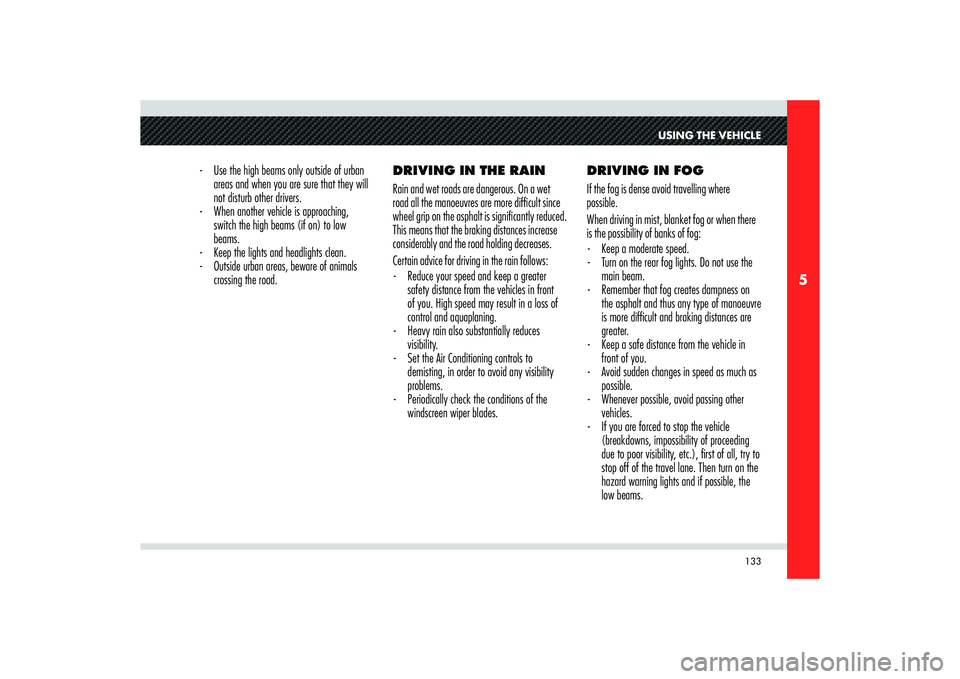
133
5
USING THE VEHICLE
- Use the high beams only outside of urban
areas and when you are sure that they will
not disturb other drivers.
- When another vehicle is approaching,
switch the high beams (if on) to low
beams.
- Keep the lights and headlights clean.
- Outside urban areas, beware of animals
crossing the road. DRIVING IN THE RAIN
Rain and wet roads are dangerous. On a wet
road all the manoeuvres are more difficult since
wheel grip on the asphalt is significantly reduced.
This means that the braking distances increase
considerably and the road holding decreases.
Certain advice for driving in the rain follows:
- Reduce your speed and keep a greater
safety distance from the vehicles in front
of you. High speed may result in a loss of
control and aquaplaning.
- Heavy rain also substantially reduces
visibility.
- Set the Air Conditioning controls to
demisting, in order to avoid any visibility
problems.
- Periodically check the conditions of the
windscreen wiper blades. DRIVING IN FOG
If the fog is dense avoid travelling where
possible.
When driving in mist, blanket fog or when there
is the possibility of banks of fog:
- Keep a moderate speed.
- Turn on the rear fog lights. Do not use the
main beam.
- Remember that fog creates dampness on
the asphalt and thus any type of manoeuvre
is more diffi cult and braking distances are
greater.
- Keep a safe distance from the vehicle in
front of you.
- Avoid sudden changes in speed as much as
possible.
- Whenever possible, avoid passing other
vehicles.
- If you are forced to stop the vehicle
(breakdowns, impossibility of proceeding
due to poor visibility, etc.), fi rst of all, try to
stop off of the travel lane. Then turn on the
hazard warning lights and if possible, the
low beams.
Page 152 of 223
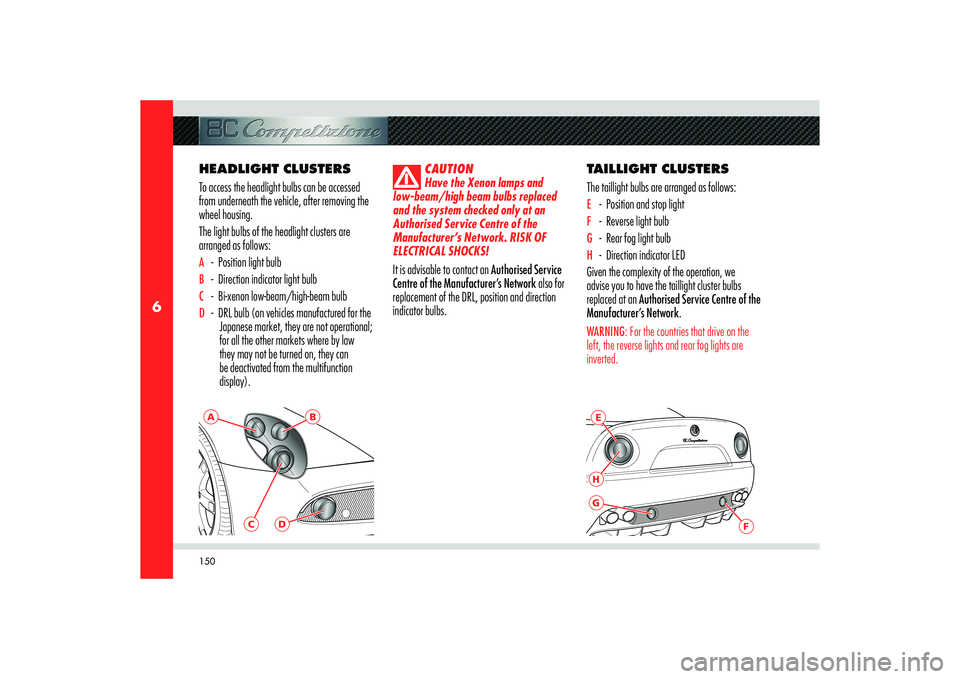
150
6
E
F
HG
A
B
C
D
HEADLIGHT CLUSTERS
To access the headlight bulbs can be accessed
from underneath the vehicle, after removing the
wheel housing.
The light bulbs of the headlight clusters are
arranged as follows:A - Position light bulb B - Direction indicator light bulbC - Bi-xenon low-beam/high-beam bulbD - DRL bulb (on vehicles manufactured for the
Japanese market, they are not operational;
for all the other markets where by law
they may not be turned on, they can
be deactivated from the multifunction
display).
CAUTION
Have the Xenon lamps and
low-beam/high beam bulbs replaced
and the system checked only at an
Authorised Service Centre of the
Manufacturer’s Network. RISK OF
ELECTRICAL SHOCKS!
It is advisable to contact an Authorised Service
Centre of the Manufacturer’s Network also for
replacement of the DRL, position and direction
indicator bulbs.
TAILLIGHT CLUSTERS
The taillight bulbs are arranged as follows:E - Position and stop lightF - Reverse light bulbG - Rear fog light bulbH - Direction indicator LED
Given the complexity of the operation, we
advise you to have the taillight cluster bulbs
replaced at an Authorised Service Centre of the
Manufacturer’s Network.WARNING: For the countries that drive on the
left, the reverse lights and rear fog lights are
inverted.
Page 166 of 223
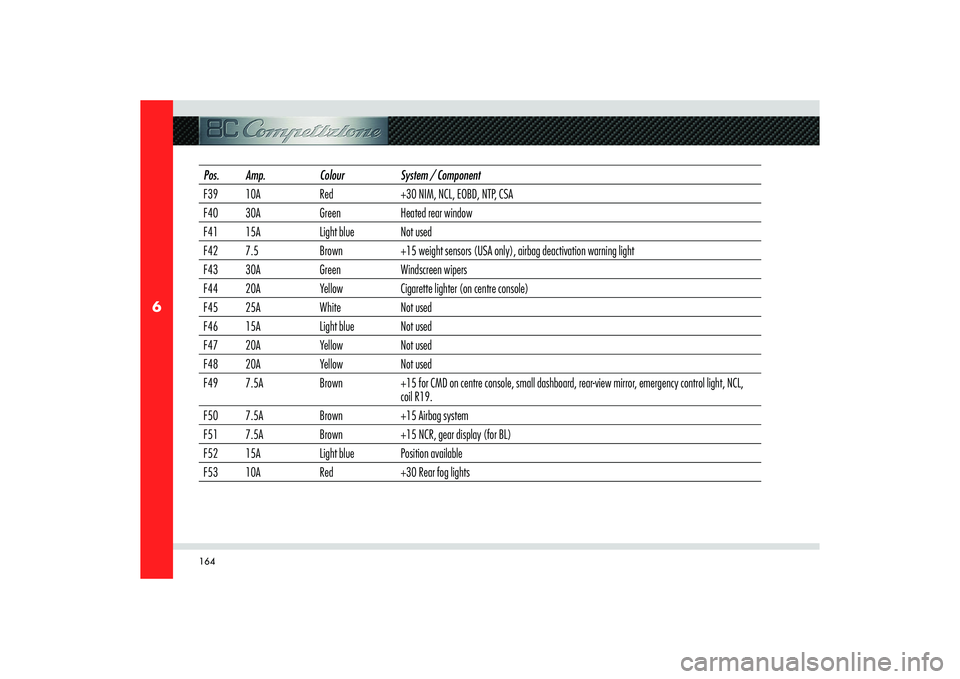
164
6
Pos. Amp. Colour System / Component
F39 10A Red +30 NIM, NCL, EOBD, NTP, CSA
F40 30A Green Heated rear window
F41 15A Light blue Not used
F42 7.5 Brown +15 weight sensors (USA only), airbag deactivation warning light
F43 30A Green Windscreen wipers
F44 20A Yellow Cigarette lighter (on centre console)
F45 25A White Not used
F46 15A Light blue Not used
F47 20A Yellow Not used
F48 20A Yellow Not used
F49 7.5A Brown +15 for CMD on centre console, small dashboard, rear-view mirror, emergency control light, NCL,
coil R19.
F50 7.5A Brown +15 Airbag system
F51 7.5A Brown +15 NCR, gear display (for BL)
F52 15A Light blue Position available
F53 10A Red +30 Rear fog lights
Page 220 of 223
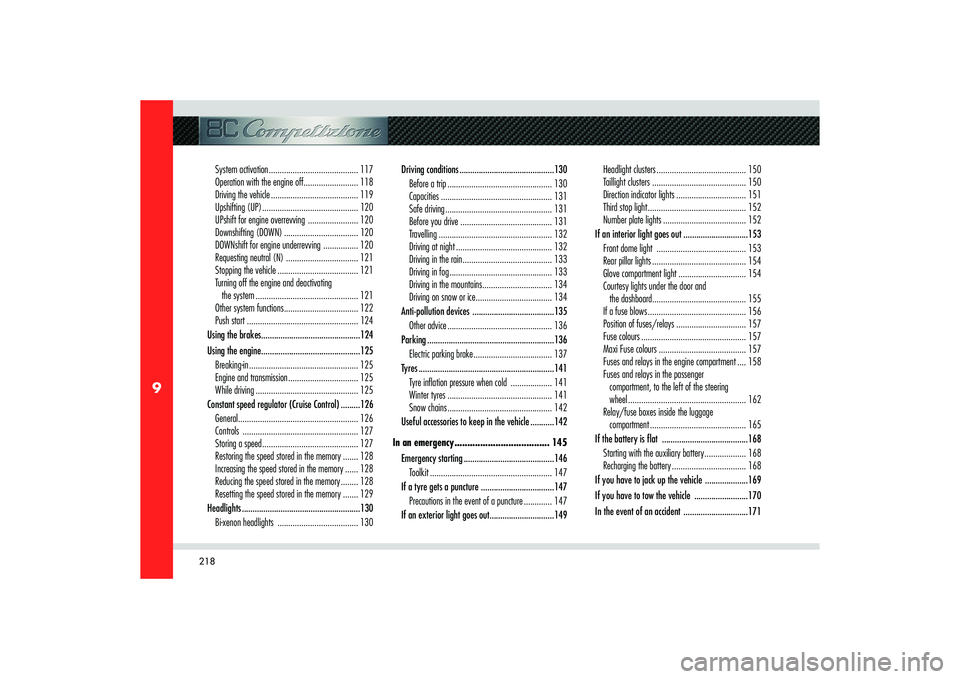
218
9
System activation ......................................... 117
Operation with the engine off ......................... 118
Driving the vehicle ........................................ 119
Upshifting (UP) ............................................ 120
UPshift for engine overrevving ....................... 120
Downshifting (DOWN) .................................. 120
DOWNshift for engine underrevving ................ 120
Requesting neutral (N) ................................. 121
Stopping the vehicle ..................................... 121
Turning off the engine and deactivating
the system ............................................... 121
Other system functions .................................. 122
Push start ................................................... 124
Using the brakes ..............................................124
Using the engine ..............................................125
Breaking-in .................................................. 125
Engine and transmission ................................ 125
While driving ............................................... 125
Constant speed regulator (Cruise Control) .........126
General ....................................................... 126
Controls ..................................................... 127
Storing a speed ............................................ 127
Restoring the speed stored in the memory ....... 128
Increasing the speed stored in the memory ...... 128
Reducing the speed stored in the memory ........ 128
Resetting the speed stored in the memory ....... 129
Headlights .......................................................130
Bi-xenon headlights ..................................... 130Driving conditions ............................................130
Before a trip ................................................ 130
Capacities ................................................... 131
Safe driving ................................................. 131
Before you drive .......................................... 131
Travelling .................................................... 132
Driving at night ............................................ 132
Driving in the rain ......................................... 133
Driving in fog ............................................... 133
Driving in the mountains ................................ 134
Driving on snow or ice ................................... 134
Anti-pollution devices ......................................135
Other advice ................................................ 136
Parking ...........................................................136
Electric parking brake .................................... 137
Tyres ...............................................................141
Tyre infl ation pressure when cold ................... 141
Winter tyres ................................................ 141
Snow chains ................................................ 142
Useful accessories to keep in the vehicle ...........142
In an emergency ..................................... 145
Emergency starting ..........................................146
Toolkit ........................................................ 147
If a tyre gets a puncture ..................................147
Precautions in the event of a puncture ............. 147
If an exterior light goes out ..............................149Headlight clusters ......................................... 150
Taillight clusters ........................................... 150
Direction indicator lights ................................ 151
Third stop light ............................................. 152
Number plate lights ...................................... 152
If an interior light goes out ..............................153
Front dome light ......................................... 153
Rear pillar lights ........................................... 154
Glove compartment light ............................... 154
Courtesy lights under the door and
the dashboard ........................................... 155
If a fuse blows ............................................. 156
Position of fuses/relays ................................ 157
Fuse colours ................................................ 157
Maxi Fuse colours ........................................ 157
Fuses and relays in the engine compartment .... 158
Fuses and relays in the passenger
compartment, to the left of the steering
wheel ...................................................... 162
Relay/fuse boxes inside the luggage
compartment ............................................ 165
If the battery is � at ........................................168
Starting with the auxiliary battery ................... 168
Recharging the battery .................................. 168
If you have to jack up the vehicle ....................169
If you have to tow the vehicle .........................170
In the event of an accident ..............................171